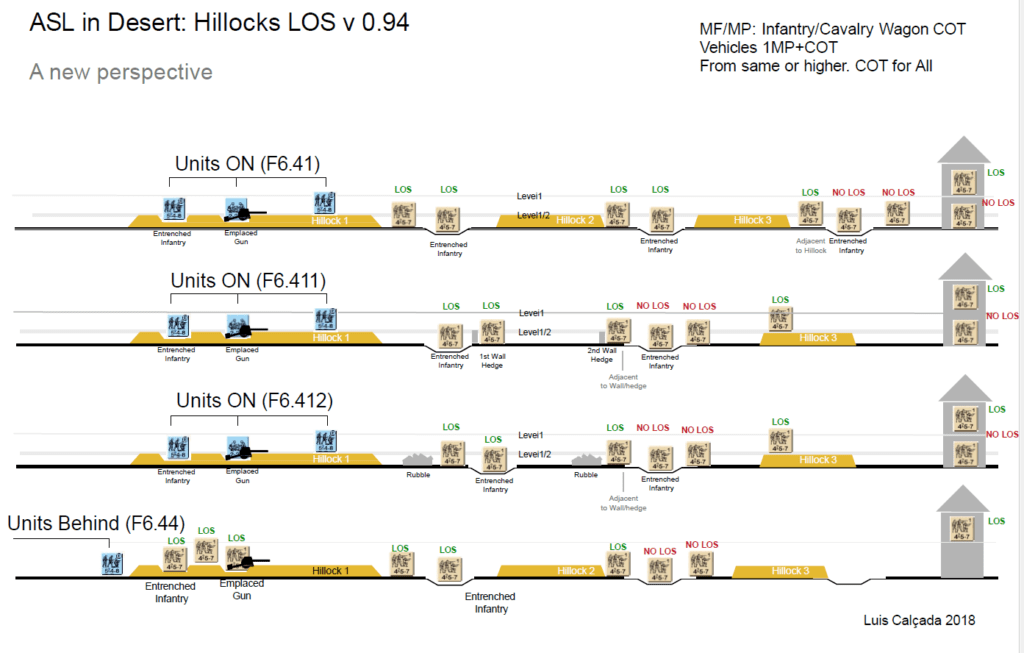I came across this graphic originally made by Luis Calçada when working on my Embankment Railroad article. I reached out to Luis and asked for the original so I could correct some small errors in the graphic. At this point, I think it does a good job depicting LOS for DTO scenarios. I post the image here for completeness. The actual PDF scales much better. I am sharing it here with Luis’ permission. Thanks Luis! — jim
UPDATE: Tony D. found an error on the graphic. I have updated it. I am sorry for the mistake.
UPDATE: Dave found a typo and a missing “Green LOS” label. The graphic and download have been updated to reflect the changes. Thanks Dave.


minor nit, title says 0.91, filename 0.92.
I do not understand why F6.411 (and F6.412) the ground level unit behind but not adjacent to the 2nd wall/rubble is in LOS. Are not the topmost level of those wall/rubble = to the 1/2 level of the Hillock?
> on a hillock has a LOS past all walls/hedges whose topmost height along that LOS is < the viewing unit’s elevation. Such a viewing unit also has a LOS past the first wall/hedge whose topmost height along that LOS equals the viewing unit’s elevation—and can also see along that same LOS past a second such wall/hedge but only to Locations that are behind but adjacent to this second wall/hedge, and beyond such Locations to ≥ the viewing unit’s elevation.
Thanks
I have updated to .93. I should really refrain from doing graphics. All of my focus is on making sure the graphic looks pleasing and I miss the details of the rules. I wouldn’t expect to see too many of these in the future.
FWIW, there as a NO LOS behind the LOS in the original Power Point. I must have dragged something, or copied something. I don’t know, but it was right in the original and I made it worse. Sorry for that.
Thanks for catching the mistake.
Thanks for telling me about the title name. I will correct that.
On the rest, you are correct. Look for a v3 shortly.
You know, this hillock graphic helped me with Up-Slopes.
I have considered doing a slopes article. So many people are against them. There was a real good one in one of the BFP products.
A minor pair of typos on the F6.411 line: “Wedge” should be “Hedge,” and I believe that there should be a green “LOS” above the counter that is marked “1st Wall Wedge.”
Thanks Dave. I have made the corrections.
Thanks Jim. This is very useful for the Prokhorovka module, hillocks, slopes, reduced blind hex creation, height advantage changes, and combo hindrances. It’s been a bit of a challenge to grok, that’s for sure.
It appears the bottom most graphic (units behind) is in error. The entrenched unit between Hillock 1 and Hillock 2 should be out of LOS. See F6.43 and Squad B in the example (note it has no LOS to Squad K).
In the example you cite, squad B is behind AND entrenched. In the graphic, the unit on the furthest left–who LOS is being measured to and from, is not. The graphic on the LOS aid represents squad A (on the left) and any number of other squads to the right of the first Hillock.
There probably should be a new line added for an entrenched squad (AKA squad B) but I find that one fairly easy to recognize.
Ah, I was misunderstanding the graphic representation – though now it seems very obvious. I was assuming the entrenched squad between Hillock 1 and Hillock 2 was adjacent to Hillock 1 – which would have had blocked LOS. But I now understand the implication in the graphic is that since the adjacent unit is not entrenched the implication is that LOS would be blocked if it were entrenched. One does sort of have to know the rule in advance to infer that though.
Yeah, maybe a fifth line with entrenched behind clearly showing only LOS to the units ON the embankment (and the level 1 building) and marked F6.43 would be worthwhile. Currently, even using reciprocity, nowhere does the figure have any LOS example for an adjacent entrenched unit.
Also might be worth putting a unit on Hillock 3 on line 4 with green LOS as well for clarity. Right now one has to use reciprocity on line 1 to make that conclusion and the lack of a unit there might make someone think there is no LOS if only looking at the Behind case.
Again, thanks (and to Luis) for a graphic much easier to follow than the Chapter F example.
Jim,
Thanks for this article. I just read your article in Journal 15. It’s great work!